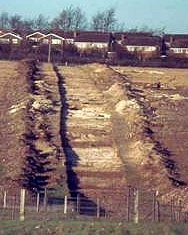Basingstoke: a short history
Basingstoke is an ancient town. Domesday Book recorded its market, three mills and land for 20 ploughs. During the Middle Ages and 16th century, the cloth industry ensured the prosperity of the town. In 1524 Basingstoke was the fourth most important town in Hampshire, ahead of Andover and Portsmouth. The cloth industry declined during the 17th century, while agriculture and malting prospered.
From the 1850s, Basingstoke developed from an agricultural town to a manufacturing centre. The VCH Short soon to be published describes in detail this transformation during the 19th and 20th centuries. A second transformation arose from town redevelopment in the 1960s, which involved the demolition and rebuilding of much of the town centre.
The origins of the town are vague. There is evidence of Palaeolithic and Neolithic settlement on the down to the west of the modern town centre. And it was a crossing of track ways, the source of the River Loddon, an outlying settlement, or “stoke”, near the larger village of Basing (an Anglo-Saxon holding of the Basingas). Nearby there were two major Roman roads which let to the town of Calleva Atrebatum, now Silchester.
Basingstoke was well-connected, situated on the main route from London to the south through Winchester, trading in agricultural produce and cloth made in the area. It became a major hub on the turnpike routes north through Reading and Oxford, east to London, south-west via Salisbury to Exeter, and south through Winchester to Southampton, at one time servicing over 37 coaches a day. It was in the right place.
Basingstoke, unusually for an agricultural town, built a canal in 1792 to take produce to London; this was unfortunately a failure The London and South Western Railway, opened in 1839, followed by the Great Western Railway to Reading, providing links to the north.



Because of the rail hub – and unusually for this part of England – the town began developing heavy industry and manufacturing in the 19th century, along with all the associated trades and services and population change.
Wallis & Steevens Ltd was founded in 1856, initially called Wallis & Haslam, producing small agricultural machinery and then moving on to steam powered traction engines, wagons and road rollers, shifting to diesel-powered engines in the 1920s. The company ceased to exist in 1981.
Thornycroft started as a marine engineering company and expanded into building steam-powered road vehicles. To feed demand a new factory was built in Basingstoke in 1898. Army vehicles and buses were also produced, and the firm became a world class provider of commercial and military vehicles through two world wars. The factory was a major employer in the town until 1969.
Burberry, the world-famous fashion brand, started in Basingstoke when Thomas Burberry built his shop in the town in 1856 and grew into a clothing manufacturing business. Burberry is renowned for developing Gabardine, a weatherproof cloth used widely in civil and military environments, and notably in the early 19th century Antarctic expeditions. Thomas Burberry was a significant presence in the town, and an important employer. The successful business moved out of the town, and the Basingstoke factory was finally closed in 1957.
All these enterprises have now completely disappeared from the town.



The mid-20th century saw another huge expansion of the town with the planned resettling of London population overflow, with large road and town development schemes, including the routing of the M3 motorway immediately to the south. Much of the old town centre was destroyed in the process to be replaced by shopping centres. Its proximity to London enabled many national and international companies to move their headquarters out of the capital, and, with the railway links providing commuter access, population and infrastructure increased dramatically.


DETAILS OF THE IMAGES:
1. 9th century skull of a young woman found at Oakridge prior to housing development. Read about it in our Autumn 2020 newsletter.
2. Coach Ruts, Kempshott Hill, tracks found by pre-development archaeology at Hatch Warren. Read about it in our Spring 2016 newsletter. Image: Bob Applin
3. Canal narrowboat, “Basingstoke”. Read about this and the Basingstoke Canal in our Spring 2016 newsletter. Image: Derek Spruce
4. W&S “Advance” road roller, as seen at Milestones Museum, Basingstoke. Image: Bob Applin
5. Thornycroft 1934 “Handy” dropside lorry. Image: Les Chatfield, Wikipedia, distributed under a CC-BY 2.0 license
6. Burberry’s first shop in Basingstoke, the Emporium. Image Wikimeda, public domain.
7. Statue of Jane Austen outside the Willis Museum. She lived in Steventon, shopped and socialised in Basingstoke. The statue was created by Adam Roud and unveiled by her biographer, Claire Tomalin, on 18 July 2017. Image: Barbara Large
8. Festival Place, Basingstoke’s main shopping centre, replaced much of the old town centre. Image: The copyright on this image is owned by Andrew Smith and is licensed for reuse under the Creative Commons Attribution-ShareAlike 2.0 license.
